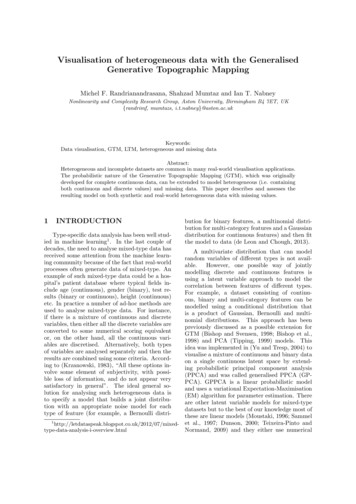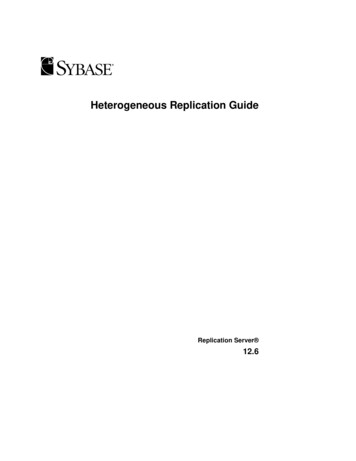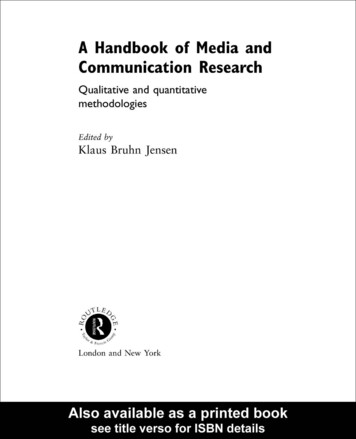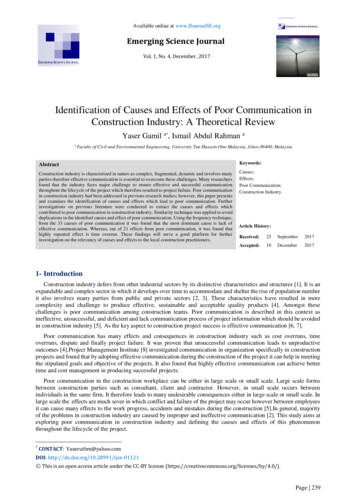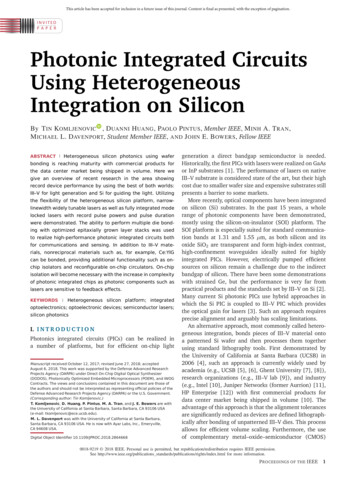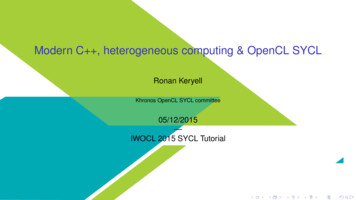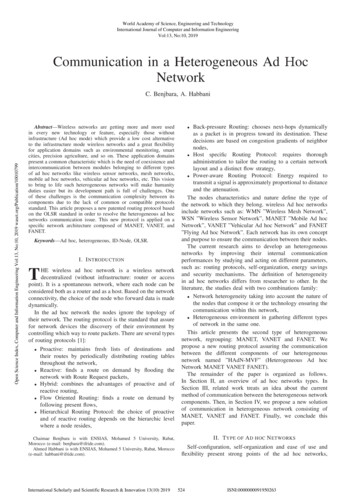
Transcription
World Academy of Science, Engineering and TechnologyInternational Journal of Computer and Information EngineeringVol:13, No:10, 2019Communication in a Heterogeneous Ad HocNetworkOpen Science Index, Computer and Information Engineering Vol:13, No:10, 2019 waset.org/Publication/10010799C. Benjbara, A. HabbaniAbstract—Wireless networks are getting more and more usedin every new technology or feature, especially those withoutinfrastructure (Ad hoc mode) which provide a low cost alternativeto the infrastructure mode wireless networks and a great flexibilityfor application domains such as environmental monitoring, smartcities, precision agriculture, and so on. These application domainspresent a common characteristic which is the need of coexistence andintercommunication between modules belonging to different typesof ad hoc networks like wireless sensor networks, mesh networks,mobile ad hoc networks, vehicular ad hoc networks, etc. This visionto bring to life such heterogeneous networks will make humanityduties easier but its development path is full of challenges. Oneof these challenges is the communication complexity between itscomponents due to the lack of common or compatible protocolsstandard. This article proposes a new patented routing protocol basedon the OLSR standard in order to resolve the heterogeneous ad hocnetworks communication issue. This new protocol is applied on aspecific network architecture composed of MANET, VANET, andFANET.Keywords—Ad hoc, heterogeneous, ID-Node, OLSR.I. I NTRODUCTIONTHE wireless ad hoc network is a wireless networkdecentralized (without infrastructure: router or accesspoint). It is a spontaneous network, where each node can beconsidered both as a router and as a host. Based on the networkconnectivity, the choice of the node who forward data is madedynamically.In the ad hoc network the nodes ignore the topology oftheir network. The routing protocol is the standard that assurefor network devices the discovery of their environment bycontrolling which way to route packets. There are several typesof routing protocols [1]: Proactive: maintains fresh lists of destinations andtheir routes by periodically distributing routing tablesthroughout the network,Reactive: finds a route on demand by flooding thenetwork with Route Request packets,Hybrid: combines the advantages of proactive and ofreactive routing,Flow Oriented Routing: finds a route on demand byfollowing present flows,Hierarchical Routing Protocol: the choice of proactiveand of reactive routing depends on the hierarchic levelwhere a node resides,Chaimae Benjbara is with ENSIAS, Mohamed 5 University, Rabat,Morocco (e-mail: benjbara@ifride.com).Ahmed Habbani is with ENSIAS, Mohamed 5 University, Rabat, Morocco(e-mail: habbani@ifride.com).International Scholarly and Scientific Research & Innovation 13(10) 2019Back-pressure Routing: chooses next-hops dynamicallyas a packet is in progress toward its destination. Thesedecisions are based on congestion gradients of neighbornodes, Host specific Routing Protocol: requires thoroughadministration to tailor the routing to a certain networklayout and a distinct flow strategy, Power-aware Routing Protocol: Energy required totransmit a signal is approximately proportional to distanceand the attenuation.The nodes characteristics and nature define the type ofthe network to which they belong. wireless Ad hoc networksinclude networks such as: WMN ”Wireless Mesh Network”,WSN ”Wireless Sensor Network”, MANET ”Mobile Ad hocNetwork”, VANET ”Vehicular Ad hoc Network” and FANET”Flying Ad hoc Network”. Each network has its own conceptand purpose to ensure the communication between their nodes.The current research aims to develop an heterogeneousnetworks by improving their internal communicationperformances by studying and acting on different parameters,such as: routing protocols, self-organization, energy savingsand security mechanisms. The definition of heterogeneityin ad hoc networks differs from researcher to other. In theliterature, the studies deal with two combinations family: Network heterogeneity taking into account the nature ofthe nodes that compose it or the technology ensuring thecommunication within this network, Heterogeneous environment in gathering different typesof network in the same one.This article presents the second type of heterogeneousnetwork, regrouping: MANET, VANET and FANET. Wepropose a new routing protocol assuring the communicationbetween the different components of our heterogeneousnetwork named ”HAdN-MVF” (Heterogeneous Ad hocNetwork MANET VANET FANET).The remainder of the paper is organized as follows.In Section II, an overview of ad hoc networks types. InSection III, related work treats an idea about the currentmethod of communication between the heterogeneous networkcomponents. Then, in Section IV, we propose a new solutionof communication in heterogeneous network consisting ofMANET, VANET and FANET. Finally, we conclude thispaper. II. T YPE OF A D HOC N ETWORKSSelf-configuration, self-organization and ease of use andflexibility present strong points of the ad hoc networks,524ISNI:0000000091950263
World Academy of Science, Engineering and TechnologyInternational Journal of Computer and Information EngineeringVol:13, No:10, 2019making this type of network very useful in critical areassuch as: Military, health, security road, agriculture, safetyenvironmental and human. To benefit from these advantagesand to meet the needs of use, the ad hoc networks are dividedinto several subsets:the field of application. Integrated processors to record andprocess recover data and low power radios that transmit thisdata to the user.In an ad hoc mode WSN network, it is necessary tochoose the correct routing protocol to ensure the transmissionof data to the destination. According to the latest studies,the reactive routing protocols on-demand more precisely theAODV protocol works better in the WSN, it gives the bestperformances for example: end to end delay, throughput, andpacket delivery ratio.Open Science Index, Computer and Information Engineering Vol:13, No:10, 2019 waset.org/Publication/10010799C. MANET: Mobile Ad hoc NetworkFig. 1 Type of ad hoc networkA. WMN: Wireless Mesh NetworkA wireless mesh network, as the name suggests is aradio communication network based on a mesh topology. Thearchitecture of this network is mainly made up of: mesh clientsusually mobile like laptops, mobile phones and other wirelessequipment and mesh routers and gateways that are mostly fixedensuring the exchange of data between nodes.The routing protocol is needed to maintain and reconstructthe routes as mesh-client communication progresses. Themajority of researchers have agreed that reactive on-demandrouting protocols are more suitable for WMNs, such as:HOVER, AODV, WMR, [2].By using alternative paths and multi-hop routing, WMNcan overcome data transmission failures due to mobility,interference, and congestion, and can also increase the batterylife of mobile nodes. Due to these and many other advantages,WMNs have been targeted at various applications such asdisaster relief, metropolitan area networks.B. WSN: Wireless Sensor NetworkThe wireless sensor network is a monitoring and trackingsystem composed of sensor nodes that are characterizedby their intelligence, small size and economical side: cost,consumption of energy or power. WSN can be organized intwo modes [3]: structured involves the deployment plan ofSensor nodes and unstructured the sensor node is deployedad-hoc i.e communication without infrastructure betweennodes. They are used in many areas: traffic control, vehicledetection, greenhouse monitoring, etc.Each node of the WSN network consists of one or moresensors to collect physical or environmental parameters suchas: pressure, humidity, temperature, and others depending onInternational Scholarly and Scientific Research & Innovation 13(10) 2019MANET is a network composed of many free wirelessnodes that can be transmitters / receivers or routers forminga dynamic topology without infrastructure that changesfrequently and unpredictably. This type of network can operateautonomously or be connected to the Internet. a MANETnetwork is composed of different devices such as: computer,PDA, mobile phone, etc.since the 1990s, researchers have been trying to remedyand find relevant solutions to the problems and challengesof MANET networks linked to their decentralized nature andhigh mobility. To ensure reliable and robust communicationbetween nodes when transmitting data, the best routingprotocol must be chosen. the comparison studies betweenrouting protocols of ad hoc networks: Proactive, Reactiveand Hybrids, concluded that proactive protocols like OLSRmake it possible to reach a better level of communicationcompared to other protocol families. But, we can say that thechoice of protocol is related to the field of application and theperformances that we want to ensure.There are several applications for MANET such as militarybattlefield communications, search and rescue operationsin disastrous situations such as earthquakes or informationsharing during an interactive conference.D. VANET: Vehicular Ad hoc NetworkVANET is a special form of MANETs where the nodes arecirculating in an intelligent road network with well organizedinfrastructure. VANET creates a mobile vehicular networkwith a wide range assuring three types of communication:Vehicle-to-Vehicle (V2V) and Vehicle-to-Roadside (VRC) orVehicle-to-Infrastructure (V2I).Each vehicle in the VANET architecture is equipped witha set of vendor-supplied applications installed in a devicecalled an ”Application Unit” which can be single or multiple.”AU” accesses the network only via the on-board unit ”OBU”presenting the communication core of the vehicle with itsenvironment which includes other nodes (i.e other OBUs) anddevices with waves called ”RSU” (Road-Side Unit) installedalong the road network. ”OBU” provides the node with severalservices such as: wireless radio access, ad-hoc and geographicrouting, network congestion control, reliable message transferand data security. the ”RSU” equipment is fixed, connectedto the backbone network and mainly exchanges securitymessages with ”OBU” [4].525ISNI:0000000091950263
World Academy of Science, Engineering and TechnologyInternational Journal of Computer and Information EngineeringVol:13, No:10, 2019Open Science Index, Computer and Information Engineering Vol:13, No:10, 2019 waset.org/Publication/10010799According to recent studies, two large protocol familiescan provide communication within VANET networks: protocolbased on the topology and protocol based on the geographicaldata of the nodes. But, according to the results of the differentsimulations made, the geographical protocols especially GPSRproved more reliable in term of result of routing and responsetime. The rest of the routing protocols (proactive: OLSR,reagent: AODV) remain with good performance and efficiencyin the vehicular network.VANETs are intended for a wide range of roadnetwork applications: vehicle safety, automated tolling, trafficmanagement, enhanced navigation, Geo-localization services.a VANET node can transmit warnings about environmentalhazards, traffic and road conditions and regional informationto other vehicles.III. R ELATED W ORKA. An Inter-Domain Routing for Heterogeneous Mobile AdHoc NetworksIn heterogeneous ad hoc networks (MANET, VANET andMesh), the communication between its components (nodes) isimpossible. Because, every network uses a routing protocolspecific to its own environment. So, there is a lack ofinteroperability between the different routing protocols.E. FANET: Flying Ad hoc NetworkFANET is a sub-family of MANET and VANET networks,consisting of unmanned aerial vehicles (UAVs) that requirepeer-to-peer connections for synchronization. drones areflexible, inexpensive and quick to deploy. The topology ofFANET networks is special because it is characterized by afrequent change because of the high mobility of the nodesand a wide range of communication related to the largedistance between its components. In this type of network, itis essential to collect data from the environment and send itto the command and control center. Therefore, FANET mustprovide peer-to-peer communication and converge broadcasttraffic at the corresponding time. the drone networks are veryinteresting for many civil and military applications.The dynamic topology of FANETs makes communicationcomplex within this network, so the existing routing protocolsdesigned for MANETs fail to follow changes in networktopology. To remedy this problem, a study has proposed anew version of OLSR called P-OLSR (Predictive-OLSR) [5],it takes advantage of GPS information available at the nodeto predict the evolution of the quality of wireless links.Fig. 2 ”ATR” communicationATR (Ad hoc Traversal Routing) is a solution whichresolve the problem of communication between nodescomponent the heterogeneous network. Its principle is creatingthe connectivity between the heterogeneous nodes throughgateways (ATR nodes: nodes that ATR is installed) that convertcontrol messages from one network to another, and adding thenode address of different networks into the routing table forrouting protocols.Each ATR node has two roles: node/router in its ownnetwork and gateway to allow its neighbors on the samenetwork to exchange information (data) with nodes belongingto other types of network.The converting mechanism in ATR node change accordingto type of routing protocol used:TABLE IC OMPARISON TABLE OF THE D IFFERENT A D HOC N ETWORKAd hoc network ology UAVspowerLimitedLimitedLimitedAverageVery S,IMUProtocolAODVAODVOLSRQoS-OLSR P-OLSRMPOLSRInternational Scholarly and Scientific Research & Innovation 13(10) 2019 526Reactive protocol (AODV): If the ATR node is atransmitter, it sends route request messages (RR) withinits network (node/router role) and at the same timeconverts it (Gateway role) into a new route requestmessage called ATR route request message (ATR-RR)for the different networks to transfer the route requestmessages to the neighboring ATR node of the differentnetwork. If the ATR node is the receiver node, itconverts the ATR route request message to a routerequest message and sends both messages each one to itsdestination(ATR-RR to ATR nodes and RR to neighborsin the same network).Proactive protocol (DSDV): The ATR nodes collect theaddress information of the nodes in the network to whichthey belong and each ATR node shares this collectedinformation with its neighboring ATR nodes. Then, theproactive protocol can create the route entry for nodes ofdifferent networks in the routing table.ISNI:0000000091950263
World Academy of Science, Engineering and TechnologyInternational Journal of Computer and Information EngineeringVol:13, No:10, 2019 Position-based Routing Protocol(GPSR): Wherever theATR node converts from position-based routing toproactive or reactive routing, it must transforms theposition information to the hop number by estimatingthe hop number from the position between the nodes.when ATR node converts from proactive or reactiverouting to position-based routing, ATR node includesits own position to the converted control messages forposition-based routing.IV. O UR C ONTRIBUTIONOpen Science Index, Computer and Information Engineering Vol:13, No:10, 2019 waset.org/Publication/10010799A. IntroductionAccording to the communication technique dealt withinlast section, it was noticed that the ATR node during theconversion: loses energy, consumes memory space, requiresa processing time and risks losing the link with its ATRneighbors (topology change). There is also a strong possibilityof losing information if the source has no connection with theATR node of its network.To overcome disadvantages of ATR solution inheterogeneous network, we propose a new communicationmethod ensuring the optimal, reliable and fast exchange databetween the different components of heterogeneous network.Our team (M3S: Mobile Smart Security Systems ) isworking at the network layer in ad hoc networks specificallyMANET by choosing OLSR as a routing protocol and is tryingto provide original solutions to meet the challenges of thistype of network such as security ([7], [8]), mobility [9] andreduction broadcast redundancy [10].The standard OLSR protocol is based on the exchangeof Hello and TC messages. Each node broadcasts a Hellomessage (Fig. 3 (a)) to get an overview about its neighborhood.This message transmits several information and has severalutilities such as: the type of link, the willingness of the node,information about the neighbors, etc. To build the routingtables, each node periodically sends in the throughout networka TC message (Fig. 3 (b)) containing the list of its neighbors.Fig. 3 Format of the original OLSR messagesFig. 4 ”HAdN-MVF” CommunicationB. Solution DescriptionAccording to the comparison table (TABLE I) and the studydone in Section II, we observe that the MANET, VANET andFANET networks are of the same family and use differentversions of the same routing protocol ”OLSR”.So, we decided to work on a heterogeneous networkcomposed of these three networks, named ”HAdN-MVF” andwe will assure the communication between its componentsby a new routing protocol based on ”OLSR standard”.This protocol allow to create a heterogeneous network withhomogeneous nodes speaking the same slang while keepingthe characteristics and properties of each node.We propose a new version of OLSR called ”HAR-OLSR”(Heterogeneous Ad hoc Routing OLSR) intended for thenetwork HAdN-MVF. In our patented idea[11], we proposea complete architecture of the new protocol contains manystep acting on each other before sending the data:In this article, we will treat the first step: identification ofthe node. For this, the protocol uses a new form of HelloInternational Scholarly and Scientific Research & Innovation 13(10) 2019Fig. 5 New node communication architecture527ISNI:0000000091950263
World Academy of Science, Engineering and TechnologyInternational Journal of Computer and Information EngineeringVol:13, No:10, 2019and Tc messages integrating different parameters to ensurecommunication between the heterogeneous nodes constitutingthe network.Ṽ(i,j) (t) d(i,j) (t) d(i,j) (t 1)δt(1)where:* d(i,j) (t) and d(i,j) (t 1) are the corresponding distancesbetween the nodes i and j.* δt : is the difference between the arrival time of the firstand last message Hello.The GPS coordinates accept the error. Thus, to be moreprecise in the computation of the instantaneous speed, we willcalculate its average by using an α parameter representing anexponential average. Then, the speed is represented as follows:Open Science Index, Computer and Information Engineering Vol:13, No:10, 2019 waset.org/Publication/10010799 Fig. 6 New Hello message formatFig. 6 illustrates the modified form of the Hello messagewhere green colored bytes correspond to the added fields. Weinsert in this message all the information that will make itpossible to specify the neighbor node type: The latitude and longitude as floating-point numbersoccupying 4 bytes each. The altitude as a 16-bit fixed-point number. The signal range Range also represented in a fixed-pointnumber reserving 16 bits.The new form of the hello message affects the size of thestandard message by adding 12 bytes regardless of the numberof nodes in the network. The 802.11 frame encapsulates an IPpacket that in turn encapsulates a UDP datagram containingthe hello message. The additional 12 bytes are negligibleoverhead in relation to the total size of the frame in mediumand large networks.V(i,j) (t) αṼ(i,j) (t) (1 α)V(i,j) (t 1), 0 α 1V(i,j) (0) 0(2)Every node of the network attributes an identifier toeach there neighbors basing on there range and proportionalvelocity. The ID-Node takes three values 1, 2 and 3representing MANET, VANET and FANET respectively. Thechoice of identifier respects the below organizational chart:Fig. 8 Identification organizational chartFig. 7 New TC message formatFig. 7 illustrates the new structure of the TC message byadding three bytes reserved to: The average instantaneous speed V(i,j) (t) formatted as afixed-point number occupying a block of 16-bit. The node identifier ”ID-Node” represented in afixed-point number reserving 8 bits.To calculate the average instantaneous speed, we need theinstantaneous relative velocity Ṽ(i,j) (t) between node i and itsneighbor j at time t. Thus, the relative speed is calculated asfollows:International Scholarly and Scientific Research & Innovation 13(10) 2019Each network has an unique characteristics with whom it isknown like the speed and range of its components.The choice of the range interval [10m, 3Km] that has beenset as a condition for specifying the type of node is based ona simulation founded on the traces of the actual movementof the city bus fleet of the metropolitan area of Seattle,Washington on their regular routes providing bus passengerservice throughout the city [12].On the MANET networks, we can maximize the speed to20 km/h by referring to the average speed of the marathonworld record reached by Wilson Kiprotich in 2013.V. C ONCLUSIONIn this article, we gave an overview of the different existingad hoc networks and the problem of lack communicationbetween them was disclosed. In the rest of the article, westudied a heterogeneous ad hoc network named HAdN-MVF,528ISNI:0000000091950263
Open Science Index, Computer and Information Engineering Vol:13, No:10, 2019 waset.org/Publication/10010799World Academy of Science, Engineering and TechnologyInternational Journal of Computer and Information EngineeringVol:13, No:10, 2019composed of three types of ad hoc networks MANET, VANETand FANET (Fig. 4 illustrates the network HAdN-MVF). Anew ”HAR-OLSR” protocol based on the standard OLSR hasbeen proposed for this type of network, the purpose of whichis to ensure communication between the components of theheterogeneous network while respecting their natures.HAR-OLSR is based on the identification of the neighborsby specifying the nature of their networks of membership andshared it in the whole network. The flowchart in Fig. 8 explainsthe principle of identifying nodes based on signal range andspeed of the nodes. This identification maked to be used in thesecond step ”Path Classification” of our main protocol (Fig.5) in his multipath version.In the next, we plan to implement this solution and analyzeits impact on the following metrics: End-to-End Delay, Energy,Packet Delivery Ratio and throughput.R EFERENCES[1] V. Rani and R. Dhir and B.R. Ambedkar, ”A Study of Ad-Hoc Network:A Review”. International Journal of Advanced Research in ComputerScience and Software Engineering, Volume 3, Issue 3, March 2013.[2] M. Piechowiak and P. Zwierzykowski and P. Owczarek and M. Wasowicz,”Comparative analysis of routing protocols for wireless mesh networks”.10th International Symposium on Communication Systems, Networks andDigital Signal Processing (CSNDSP), p.1-5, July 2016.[3] V. K. Kashyap and R. Astya and P. Nand and G. Pandey, ”Comparativestudy of AODV and DSR routing protocols in wireless sensor networkusing NS-2 simulator”.International Conference on Computing,Communication and Automation (ICCCA), p.687-690, May 2017.[4] B. Hari Krishna, ”Study of Ad hoc Networks with Reference to MANET,VANET, FANET”. Conference Proceedings, 2017.[5] S. Rosati and K. Kruelecki and G. Heitz and D. Floreano and B. Rimoldi,”Dynamic Routing for Flying Ad Hoc Networks”. IEEE Transactionson Vehicular Technology, volume 65, number 3, p. 1690-1700, March2016.[6] S. Fujiwara and T. Ohta and Y. Kakuda, ”An Inter-domain Routingfor Heterogeneous Mobile Ad Hoc Networks Using Packet Conversionand Address Sharing”.32nd International Conference on DistributedComputing Systems Workshops, p.349-355, June 2012.[7] F. El Mahdi, ”Nouveau procédé multi-chemin de sécurité dans lesréseaux MANET”. Patent, Ref.39226, juillet 2016.[8] H. Amraoui, A. Habbani, A. Hajami, B. Essaid, ”Security-basedmechanism for proactive routing schema using game theory model”.Mobile Information Systems, Hindawi, 2016.[9] H. AMRAOUI and A. HABBANI and A. HAJAMI, ”MobilityQuantification for MultiPoint Relays Selection Algorithm in Mobile AdHoc Networks”. 5th International Conference on Multimedia Computingand Systems (ICMCS), p.278-283, September 2016.[10] M.Souidi and A. Habbani and H. Berradi and F. El Mahdi, ”Geographicforwarding rules to reduce broadcast redundancy in mobile ad hocwireless networks”. Pers Ubiquit Comput, May 2018.[11] C. Benjbara and A. Habbani and F. El Mahdi, ”Procédé decommunication basé sur la classification des chemins multiples”. Patent,Ref.42342, April 2018.[12] Jetcheva and Hu and PalChaudhuri and Saha and Johnson, ”Designand evaluation of a metropolitan area multitier wireless ad hoc networkarchitecture”. Proceedings Fifth IEEE Workshop on Mobile ComputingSystems and Applications, p.32-43, October 2003.International Scholarly and Scientific Research & Innovation 13(10) 2019529ISNI:0000000091950263
B. WSN: Wireless Sensor Network The wireless sensor network is a monitoring and tracking system composed of sensor nodes that are characterized by their intelligence, small size and economical side: cost, consumption of energy or power. WSN can be organized in two modes [3]: structured involves the deployment plan of Sensor nodes and .
